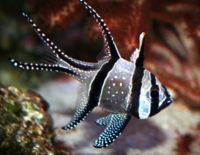Bangai Cardinalfish (Pterapogon kauderni)
From The Aquarium Wiki
Bangai Cardinalfish
Pterapogon kauderni
76 Litres (20 US G.)
6.4-7.6cm (2.5-3 ")
8.1 - 8.4
25 -28 °C (77-82.4°F)
8-12 °d
1:1 M:F
5-6 years
Family
Apogonidae
This animal is available captive bred
Contents
Additional names
- Bangai Cardinal, Banggai Cardinalfish, Bangaii Cardinal, Longfin Cardinalfish, Kaudern's Cardinalfish
Origin
- Endangered in the wild; apparently restricted to Banggai Islands, Indonesia in the Western Central Pacific Ocean.[1]
Sexing
- Males have a more angular head with an extended second dorsal fin, whereas the female has a more rounded head with a shorter dorsal fin, they can however look very similar to the untrained eye.
Breeding
- They will breed readily in captivity, they are mouthbrooders, the male holds the eggs. After 18-21 days the eggs hatch, the male releases fully developed fish on day 21 to 24.
Tank compatibility
- A good beginner reef fish, hardy but can be territorial to other Bangai's or fish similar in shape to them. Best to keep a pair, or a larger group.
Diet
- Will take most foods including bloodworms, feeder shrimp and marine flesh.
Feeding regime
- Twice a day.
Environment specifics
- An Indonesian fish which is threatened due to over collection. Also appreciates spacious tank with places to hide and swim.
Behaviour
- Not a very active fish, will often hang in one place, move, and hang about some more.
Identification
- Very distinctive fish. Iridescent white-silver base colour with three vertical black stripes down the flanks extending into the fins. Elongated tail, with white spots on all fins and flanks.
Special Note
- This fish has now been listed as threatened/endangered in the wild. Please ensure, if you are considering buying this fish, that the specimen has been captive bred and not wild caught. This species is well-known as a profuse spawner in captivity, with the male mouthbrooding the eggs. If the female is overly amorous the male will starve because he will not eat when mouthbrooding; if such a situation arises, separate the male until he is revitalised, and ready to handle another mouthbrooding.
Pictures
Videos
References
External links
- Fishbase (Mirrors:
 )
)







